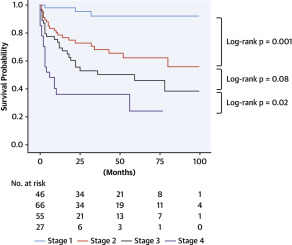JACC: Heart Failure ( IF 10.3 ) Pub Date : 2019-10-09 , DOI: 10.1016/j.jchf.2019.07.007 Christopher D Barrett 1 , Katharine Dobos 1 , Michaela Liedtke 1 , Mirela Tuzovic 1 , Francois Haddad 1 , Yukari Kobayashi 1 , Richard Lafayette 1 , Michael B Fowler 1 , Sally Arai 1 , Stanley Schrier 1 , Ronald M Witteles 1

|
Objectives
The purpose of this study was to address the overall trends in mortality since the adoption of modern therapies for treatment of systemic amyloidosis, and to reconsider the prognostic significance of individual components of the current staging system.
Background
Systemic light chain (AL) amyloidosis involves deposition of immunoglobulin light chains in organs throughout the body and is known to have the highest mortality when significant cardiac involvement is present. Survival has historically been poor but may be improving as systemic therapies continue to advance. This study assesses whether recent advancements in light chain directed therapy have led to improved survival in patients with systemic AL amyloidosis.
Methods
We reviewed all cases of patients who were evaluated for a new diagnosis of AL amyloidosis at the Stanford Amyloid Center between 2009 and 2016. Patients’ stage at diagnosis was determined according to the most commonly used staging system. Clinical data, overall survival from diagnosis, and the independent influence of each component of the staging system were analyzed.
Results
At total of 194 patients were identified with a new diagnosis of systemic AL amyloidosis. Median overall survival was 59 months and 6 months for stage 3 and 4 patients, respectively. Median overall survival was not reached in stage 1 and 2 groups, as survival was >50% by the end of the study. Mean overall survival was 118 months, 76 months, 64 months, and 27 months in Stages 1, 2, 3, and 4 patients, respectively. Although N-terminal pro–B-type natriuretic peptide and troponin I concentrations had large effects on prognosis, differences in serum free light chains (dFLC) on initial staging laboratory results ≥18 mg/dl, part of the current staging system, did not contribute significantly to prognosis for values ≥5 mg/dl.
Conclusions
Survival for patients with systemic AL amyloidosis has improved for patients at all stages of disease in the present era of rapid advancements in light chain-reducing therapies. Cardiac biomarkers at diagnosis, but not baseline dFLC ≥18 mg/dl, continue to provide important prognostic information.
中文翻译:

全身性轻链淀粉样变性病死亡率的变化趋势。
目标
这项研究的目的是解决自采用现代疗法治疗系统性淀粉样变性以来死亡率的总体趋势,并重新考虑当前分期系统各个组成部分的预后意义。
背景
全身性轻链(AL)淀粉样变性病涉及免疫球蛋白轻链在全身各器官中的沉积,已知存在明显的心脏受累时,其死亡率最高。历史上生存率很低,但随着系统疗法的不断发展,生存率可能会提高。这项研究评估了轻链定向疗法的最新进展是否已导致系统性AL淀粉样变性患者的生存期得到改善。
方法
我们回顾了所有在2009年至2016年间在斯坦福淀粉样中心接受过AL淀粉样变性新诊断评估的患者病例。根据最常用的分期系统确定患者的诊断阶段。分析了临床数据,诊断的总体生存率以及分期系统各组成部分的独立影响。
结果
总共确定了194例新诊断为系统性AL淀粉样变性的患者。3和4期患者的中位总生存期分别为59个月和6个月。在第1阶段和第2阶段组中,未达到中位总生存期,因为到研究结束时,生存率> 50%。在1、2、3和4期患者中,平均总生存期分别为118个月,76个月,64个月和27个月。尽管N端前B型利尿钠肽和肌钙蛋白I的浓度对预后有很大影响,但初始分期实验室结果≥18 mg / dl的血清游离轻链(dFLC)的差异(当前分期系统的一部分)并没有≥5mg / dl的值对预后有重大贡献。
结论
在目前轻链减少疗法迅速发展的时代,全身性AL淀粉样变性病患者的生存期已提高至疾病各个阶段的患者。诊断时的心脏生物标志物(而非基线dFLC≥18 mg / dl)继续提供重要的预后信息。











































 京公网安备 11010802027423号
京公网安备 11010802027423号